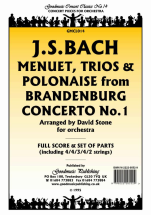Menuet, Trios and Polonaise
Buy this item (in stock)
Product ID: GM1 CL014
By Johann Sebastian Bach
Publisher:
Goodmusic
Arranger:
Stone
Series:
Concert Classics
Genre:
Baroque
Line Up:
Symphony Orchestra
Duration:
8:00
Level: 3
Set & Score
This item is in stock
About this item
This arrangement of movements from Bach's Brandenburg Concerto No.1, can be played by fairly small forces (violins with cello and/or piano if necessary), but of course wind instruments will provide the contrast which the composer intended with the Trios. When a sufficient variety of instruments is available the several repetitions of the Menuet may well be varied to some extent by omitting the flute or other woodwind parts.
In Trio II the original upper parts were for 2 horns as cued in the horn parts; if reliable trumpets are present they may be preferred to clarinets in this section.
Instrumentation
2 Flutes, Oboe, 2 Clarinets in Bb, Bassoon (or Clarinet 3) 2 Horns in F, 2 Trumpets in Bb, Trombone Strings (Violin 1, Violin 2, Viola, Cello, Bass) Piano (optional)
Reviews and rating
No review available, be the first to write one!

Composer
Johann Sebastian Bach (1685-1750)
Johann Sebastian Bach (21 March 1685, – 28 July 1750) was a German composer, organist, harpsichordist, violist, and violinist whose sacred and secular works for choir, orchestra, and solo instruments drew together the strands of the Baroque period and brought it to its ultimate maturity. Although he did not introduce new forms, he enriched the prevailing German style with a robust contrapuntal technique, an unrivalled control of harmonic and motivic organisation, and the adaptation of rhythms, forms and textures from abroad, particularly from Italy and France.
More info about the composer...



 Click above to view samples
Click above to view samples
